Polls & Surveys
Polls and Surveys campaigns allow you to collect user data—such as opinions, habits, or preferences—through questions sent via SMS, WhatsApp, or RCS. These campaigns are ideal for customer feedback, market research, and engagement.
After selecting New Campaign, naming it, and choosing Polls & Surveys, you’ll complete three setup steps:

- Delivery - Select the messaging channel (SMS, WhatsApp, or RCS) and choose the recipients who will receive the poll.
- Poll - Create your poll by adding an invitation message (optional), setting up your questions, and defining a closing message for participants.
- Summary - Review your campaign setup and choose whether to launch immediately, schedule it, or save it as a draft.
Delivery
In this step, ou define the Delivery Channel and the campaign Recipients in the Delivery step.
Currently, three delivery channels are available for the Polls & Surveys campaign:
For more information on selecting the desired delivery channel, go to the Delivery section.
For information on selecting the desired Recipients, go to Define Recipients in the Campaign Elements section.
Poll
In the Poll step, you’ll set up the invitation message, questions, and closure message. A preview of the user experience is shown on the right.
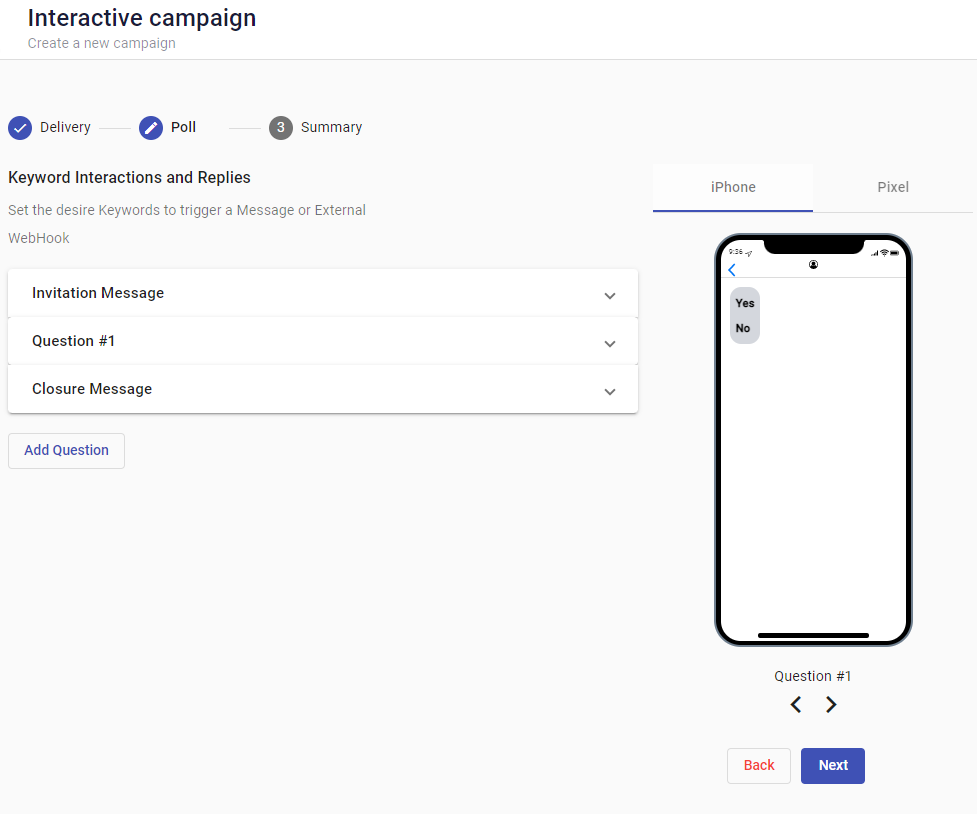
Invitation Message
The Invitation Message can serve as the campaign trigger to request poll participation if the poll is purely SMS driven, this is, only targeted recipients of this message will be aware of the Poll.
This does not need to be necessarily the case, because as part of your poll campaign, its existence could be made available to a general audience by spreading awareness of it through alternative channels; posters, billboards, airwaves, and increasing poll participation through the use of keywords.
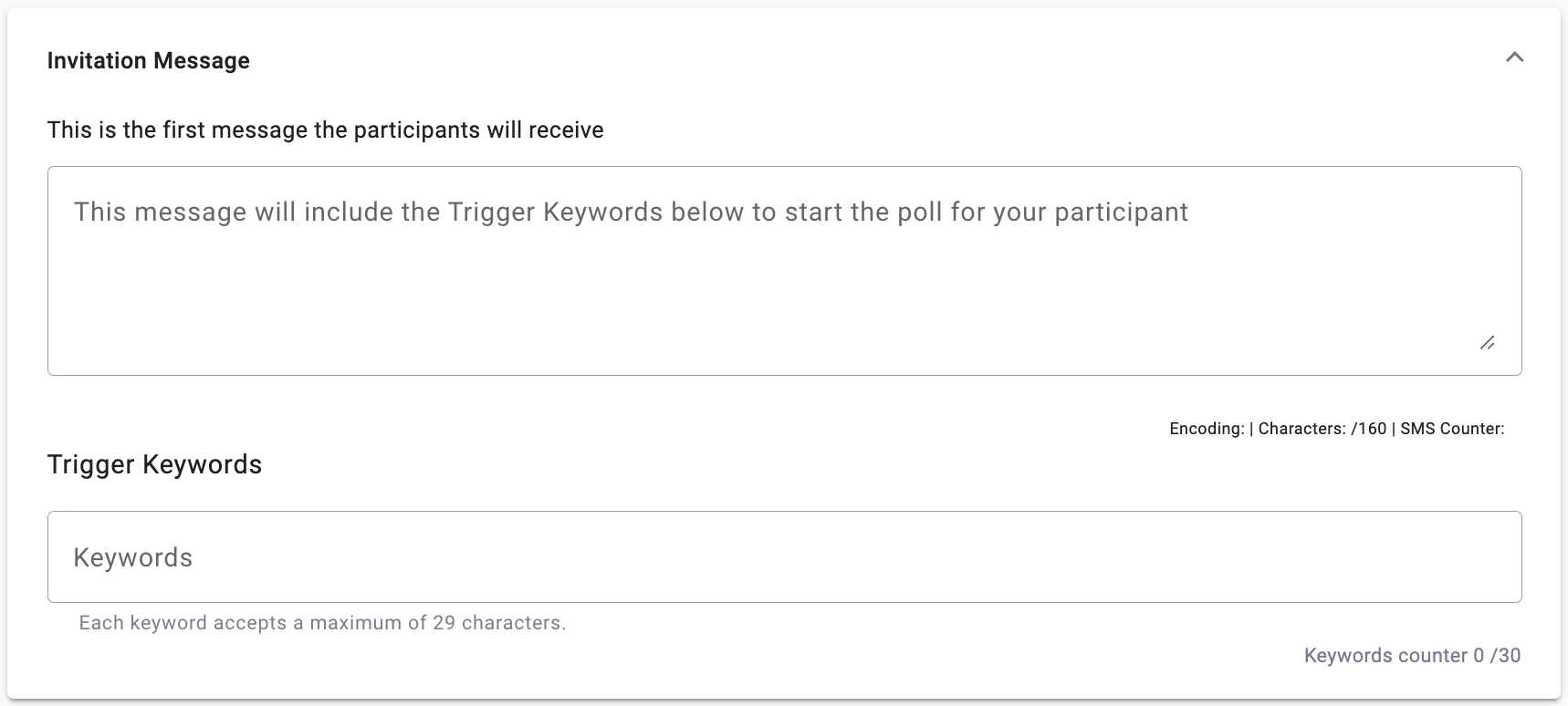
NOTEThe Invitation Message does not apply for campaigns when keywords are used as the entry point in the "Recipients" options.
Trigger Keywords
Define one or more keywords that users can send to join the poll (e.g., “START”, “VOTE”). That is, Trigger Keywords are those that invoke the poll to be delivered to the participants. Upon their reception by the platform, it will begin delivering the poll questionnaire to the participant from which the keyword was received, thus initiating the poll.
You enter the Trigger keyword or keywords in the area provided at the bottom. These keywords will be included in the Invitation Message as they are the mechanism by which to gain access to the poll and you can see this reflected in the preview screen to the right.
Questions
This section is where you configure the poll's questions that will be sent to participants.
The Question Type selected determines how the response options are structured. The platform dynamically adjusts the interface based on the question type (Yes/No, Keyword Response, Multiple Choice) chosen.
Yes/No Questions
This question type requires a binary response, where users can only reply with "Yes" or "No".

- The message box allows you to input the question that will be sent to subscribers.
- Below the message box, the system automatically assigns the keywords Yes and No as response options. That is, predefined keywords Yes and No appear automatically.
Keyword Response Questions
This question type allows users to respond with specific predefined keywords.
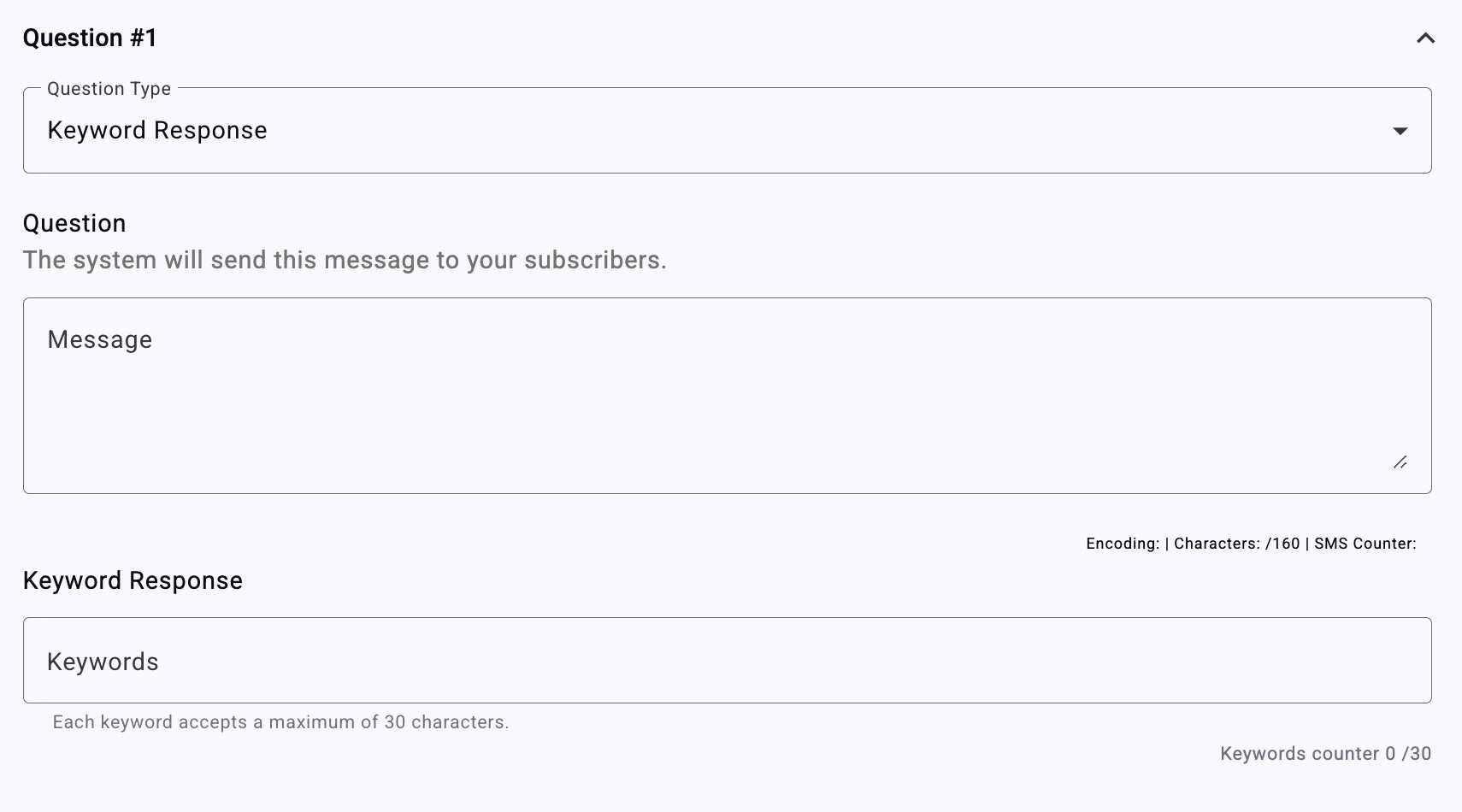
- The message box allows you to input the question that will be sent to subscribers.
- The Keyword Response field allows you to define custom keywords users must reply with.
- Keywords are not case-sensitive, so the keywords "WELCOME" and "welcome" are equivalent entries, and only one can be used as a keyword.
Multiple Choice Questions
This question type allows respondents to choose from multiple predefined answer choices.
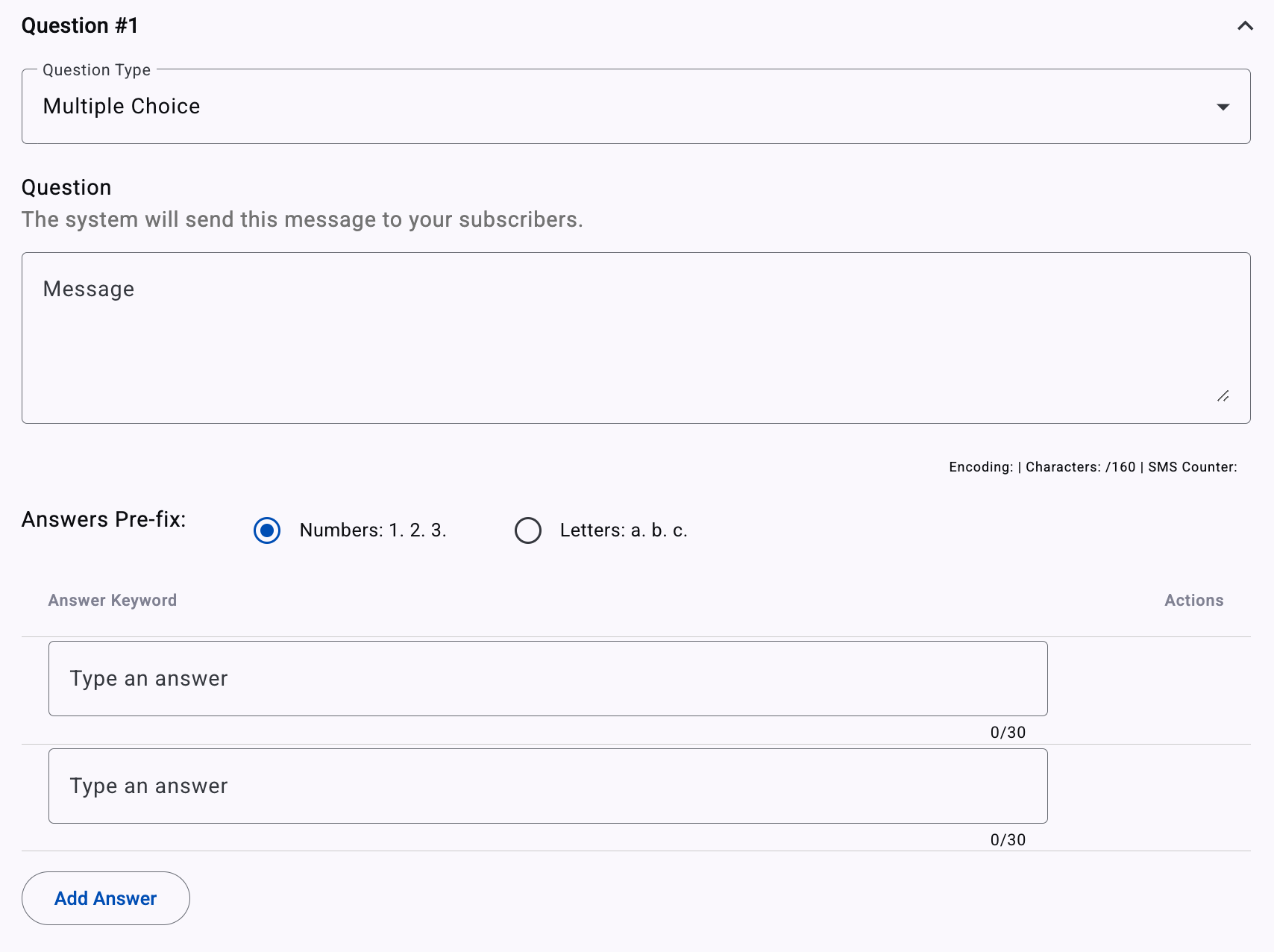
- The message box allows you to input the question that will be sent to subscribers.
- From the Answer Pre-fix, you can choose whether the answer choices are prefixed with numbers (1, 2, 3, etc.) or letters (a, b, c, etc.).
- From the Answer Keyword, define answer choices (each limited to 30 characters).
- Multiple Choice Questions can have between 2 and 5 answers.
- Answers options will be shown as a "numbered" vertical list as defined by the radio button settings on the top. Answers are limited to 10 characters each.
- To include more answers to the question, select the Add Answer button.
Closure Message
The Closure Message ensures a positive user experience by confirming participation, showing appreciation, and optionally encouraging further interaction. This message will be sent after the last question of the poll is answered.

Once the poll configuration is concluded, you can review it on the simulated screen.
Click Next to continue with the creation of the campaign.
Summary
The Summary step is where you take the final actions on your Polls & Surveys campaign.
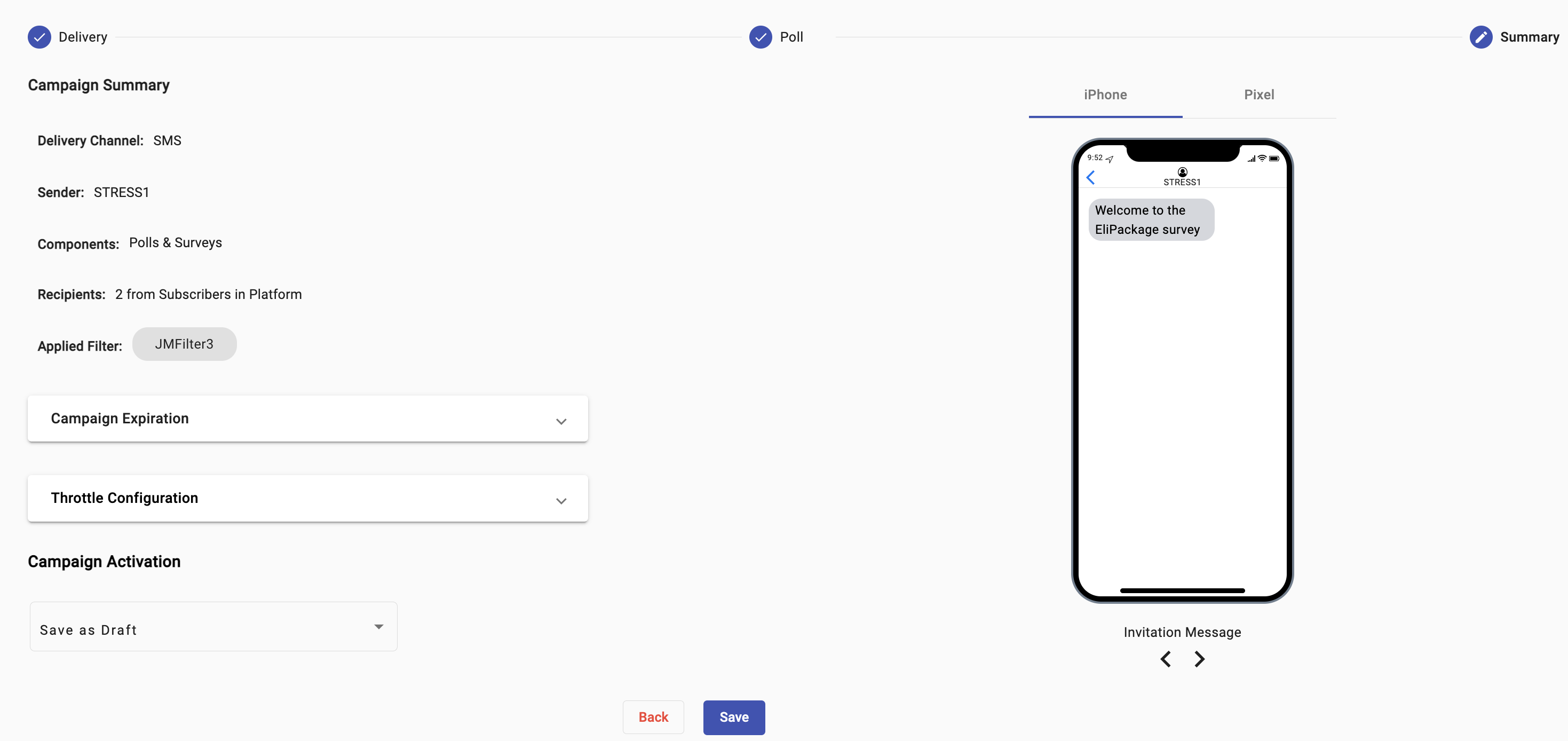
The summary step consists of the following elements:
-
Delivery Channel: Type of channel (SMS, WhatsApp, RCS) through which the campaign was sent.
-
Sender: According to the sender type selected during campaign setup is used as the sender of the notification message.
Remember, each delivery channel has its own sender type ( Sender number r Wha, Sender WhatsApp Business Account RCS [Agent, RCS - _Comp ).
-
Components: Type of components of which the interactive campaign is composed: Campaign type.
-
Recipients: Number of Recipients who will receive the campaign.
-
Applied Filter: Filter type applied.
-
Cmpaign Expiration: Configured date on which the campaign will expire.
-
Throttle Configuration: Set through the slider, the rate at which the messages will be sent.
-
Campaign Activation: Set the campaign delivery date (Live [Available if you set as delivery channel the SMS WhatsApp or WhatsApp Now, Sche), Now, Schedule, Save As Draft).
For more information about the Summary step settings, go to Summary in the Campaign Elements section.
When you deliver the Campaign you can view the data and analytics (Report) by going to the Interactive Campaign Reports section.
Updated 3 months ago
